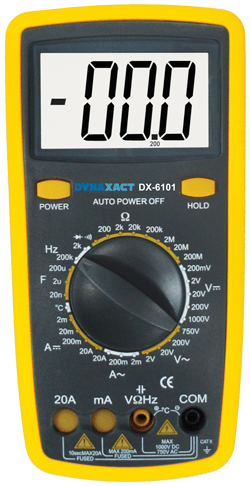
Justifying with an example, Vineet Aggarwal, product manager, National Instruments, says, “In the semiconductor industry, for chip testing there are a number of different parameters to be measured. Without automation, it would be very difficult to perform complex tests. Having the software that can run through test sequences, integrating the channels and performing necessary switching operations are key aspects of PC-based ATE systems.” In addition, some modular instruments have built-in synchronisation for stimulus-response testing.
[stextbox id=”info” caption=”Reading the digits of multimeter”]Rakesh Joshi, manager, Dynalog India, shares, “By convention, a half digit can display either a zero or a one, while a three-quarters digit can display a numeral higher than a one but not nine. Commonly, a three-quarters digit refers to a maximum value of 3 or 5. The fractional digit is always the most significant digit in the displayed value. A 3¾-digit meter can display a quantity from 0 to 3999 or 5999, depending on the manufacturer. While a digital display can easily be extended in precision, the extra digits are of no value if not accompanied by care in the design and calibration of analogue portions of the multimeter. Meaningful high-resolution measurements require a good understanding of the instrument specifications, good control of the measurement conditions, and traceability of the calibration of the instrument.[/stextbox]
“Many vendors have invested in providing an efficient software for data logging. These software are trend-plot-style graphical representation of a logged session which has been recorded by the meter. Today, not only can the user immediately view recorded results from a logging session which could have been up to 200 hours long, allowing for an instant analysis of any unusual event without the need of a PC, multiple recording sessions can also be completed and viewed right on the meter without the need for a download first. In addition to being able to view the trend information right on the screen, a cursor is available to highlight a specific event (including event detail). You can also zoom in for a closer look at the data,” explains Thakkar.
Advancement in ADCs
Analogue-to-digital converters (ADCs) are at the heart of multimeters. So when talking of multimeters, it is important to mention the improvements in ADCs in terms of sampling rate, accuracy, form-factor as well as price.
Aggarwal says, “While DMMs and oscilloscopes are distinctly different equipment, the advancement in ADCs and other analogue components has created a lot of flexible designs.”
“While selecting an instrument, typically, the trade-off that you make is faster sampling rate and less precision, or slower sampling rate and more precision. But with advanced ADC technology, you can get both faster sampling and high precision.”
Technologies like FlexADC used in high-end digitisers and multimeters give you flexible precision and dynamic range for dynamic measurements. You can switch the sample rate as per your measurement need.
Aggarwal comments, “Earlier, in the DMM architecture, a combination of an ADC and a multiplexer was used to reduce the cost, ADC being the most expensive component of the system. But now because of the overall ADC technology, the prices have come down. We are looking at devices which have more than one ADC.” He explains, “In a switching system, if you look at multiplexing across channels, there is some type of charge build-up from channel to channel. You have to allow it to settle so that it does not affect your measurement accuracy. But with a dedicated ADC for every channel, we are creating systems with higher accuracy.”
Modular and PC-based form-factors
“A multimeter with flexibility of being modular gives an upper hand as it can be clubbed with other equipment to enhance its usability in bigger applications,” says Waghchoure. Especially for diagnostics, design and high-end applications, multimeters are always clubbed with other equipment.
Today, multimeters are available in a variety of form-factors like bench-top, handheld, USB modular, PXI modular and PC-based to fit in your application and testing requirements.
Siddique says, “For field usage handheld models that are easy to carry, portable and very user-friendly are recommended, while for automated environments there are USB- or PXI-based modular multimeters.”
Thakkar adds, “For design applications or high degree of accuracy, a bench-top model can be chosen with closed eyes.”
Depending on the application, sometimes you may require a multimeter in a form factor that can fit in racks, especially in automated test environments. Siddique says, “Customers may not look for big displays or panel at that time as they don’t want to manually control and look at the instrument itself. Instead, they integrate various instruments and operate it from a single node like a computer. All the modular instrumentation today offers the equivalent of bench-top model specifications.







